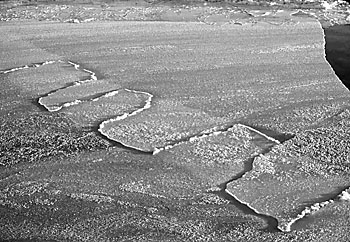 | The block zippered pattern that forms when thin ice sheets floating on water collide can be seen in this photograph taken off the Antarctic coast. The pattern of interlocking ice blocks is called "finger rafting." |
A study by Yale scientists demonstrates why ice sheets sometimes interlace when they meet, rather than riding over or under each other -- a finding that has implications for understanding other phenomena, from the plate tectonics of the Earth's surface to the design of self-assembling nanostructures.
"A surprising pattern, much like the meshed teeth of a zipper, is frequently seen when floating ice sheets collide," says John Wettlaufer, professor of geology & geophysics and of physics at Yale. He and his colleague, Dominic Vella of Cambridge University in England, suggest that the process can work for any materials that share particular physical characteristics of thickness and flexibility.
"When two elastic sheets floating on a liquid collide, intuition leads us to expect one of two results -- one sheet might be 'subducted' under the other, as we observe with the earth's crust, or the two might crush each other forming a field of rubble, as we observe in thick ice floes," says Wettlaufer.
The researchers describe a third possibility in their study, which was published in Physical Review Letters. They show that sheets of ice -- or in their experiments, sheets of wax -- form a series of interlocking blocks, termed "finger rafting," that alternately ride over and under one another. It is a curiosity that has vexed scientists for over 50 years.
The natural patterns look like meter-wide rectangular zigzags, and only occur when both sheets of ice are roughly the same thickness. The scientists' theoretical analysis was confirmed experimentally using flexible layers of wax on water to simulate the phenomenon. They demonstrated the relationship between the width of the resulting fingers and the material's mechanical properties.
"We show that this striking observation is a general and robust mechanical phenomenon that we can reproduce in the laboratory with floating materials other than ice," Wettlaufer says. "Our experimental results were consistent with the field observations."
According to the Yale scientist, the findings are relevant for a host of physical systems. "The same principles might be used for designing nanomachine gears from appropriate materials," he says. Wettlaufer also pointed out that Tuzo Wilson, one of the founders of the theory of plate tectonics, was inspired by the resemblance of structures on floating polar ice sheets to the transform faults and other features of the Earth's moving plates .
The National Science Foundation provided support for this research, which began at the summer program in Geophysical Fluid Dynamics at Woods Hole Oceanographic Institution.
-- By Janet Rettig Emanuel
T H I S
Scientists clarify why colliding
ice blocks interlace W E E K ' S
W E E K ' S S T O R I E S
S T O R I E S![]()
 Major gift to fund construction of Loria Center for the History of Art
Major gift to fund construction of Loria Center for the History of Art![]()
![]()
 Scientists determine ancient Peruvian citadel was earliest solar . . .
Scientists determine ancient Peruvian citadel was earliest solar . . .![]()
![]()
 For students, spring break will be a time of discovery, service
For students, spring break will be a time of discovery, service![]()
 SOM travel goes green
SOM travel goes green![]()
![]()
 Researchers discover treatment for lethal kidney disease
Researchers discover treatment for lethal kidney disease![]()
![]()
 Professor and trustee awarded India's highest civilian honor
Professor and trustee awarded India's highest civilian honor![]()
![]()
 Study implicates gene defect in early heart disease
Study implicates gene defect in early heart disease![]()
![]()
 Marvin Chun and John Hollander are honored by Phi Beta Kappa
Marvin Chun and John Hollander are honored by Phi Beta Kappa![]()
![]()
 Yale will help build DNA databank to further research on autism
Yale will help build DNA databank to further research on autism![]()
![]()
 Scientists clarify why colliding ice blocks interlace
Scientists clarify why colliding ice blocks interlace![]()
![]()
 Negative health effects of soft drink consumption confirmed in study
Negative health effects of soft drink consumption confirmed in study![]()
![]()
 Exhibit looks at contributions of early women healers
Exhibit looks at contributions of early women healers![]()
![]()
 Yale nurses Linda Pellico and Geralyn Spollett are lauded . . .
Yale nurses Linda Pellico and Geralyn Spollett are lauded . . .![]()
![]()
 Past, present and future Elis are named Soros Fellows
Past, present and future Elis are named Soros Fellows![]()
![]()
 Study finds that yearning -- not disbelief -- is defining feature of grief
Study finds that yearning -- not disbelief -- is defining feature of grief![]()
![]()
 Record number of city students taking part in annual science fair on campus
Record number of city students taking part in annual science fair on campus![]()
![]()
 Conference to explore new collaborations with Turkey
Conference to explore new collaborations with Turkey![]()
![]()
 IN MEMORIAM
IN MEMORIAM
 B. Davie Napier: Former Yale trustee, professor and preacher
B. Davie Napier: Former Yale trustee, professor and preacher![]()
 James B. Crowley: Specialist in the history of modern Japan
James B. Crowley: Specialist in the history of modern Japan![]()
 Paul Sevier Minear: A leading scholar of the New Testament
Paul Sevier Minear: A leading scholar of the New Testament![]()
 Kathryn Perrone: Assistant to the president
Kathryn Perrone: Assistant to the president![]()
![]()
 Campus Notes
Campus Notes![]()
Bulletin Home |
| Visiting on Campus
Visiting on Campus |
| Calendar of Events
Calendar of Events |
| In the News
In the News![]()
Bulletin Board |
| Classified Ads
Classified Ads |
| Search Archives
Search Archives |
| Deadlines
Deadlines![]()
Bulletin Staff |
| Public Affairs
Public Affairs |
| News Releases
News Releases |
| E-Mail Us
E-Mail Us |
| Yale Home
Yale Home